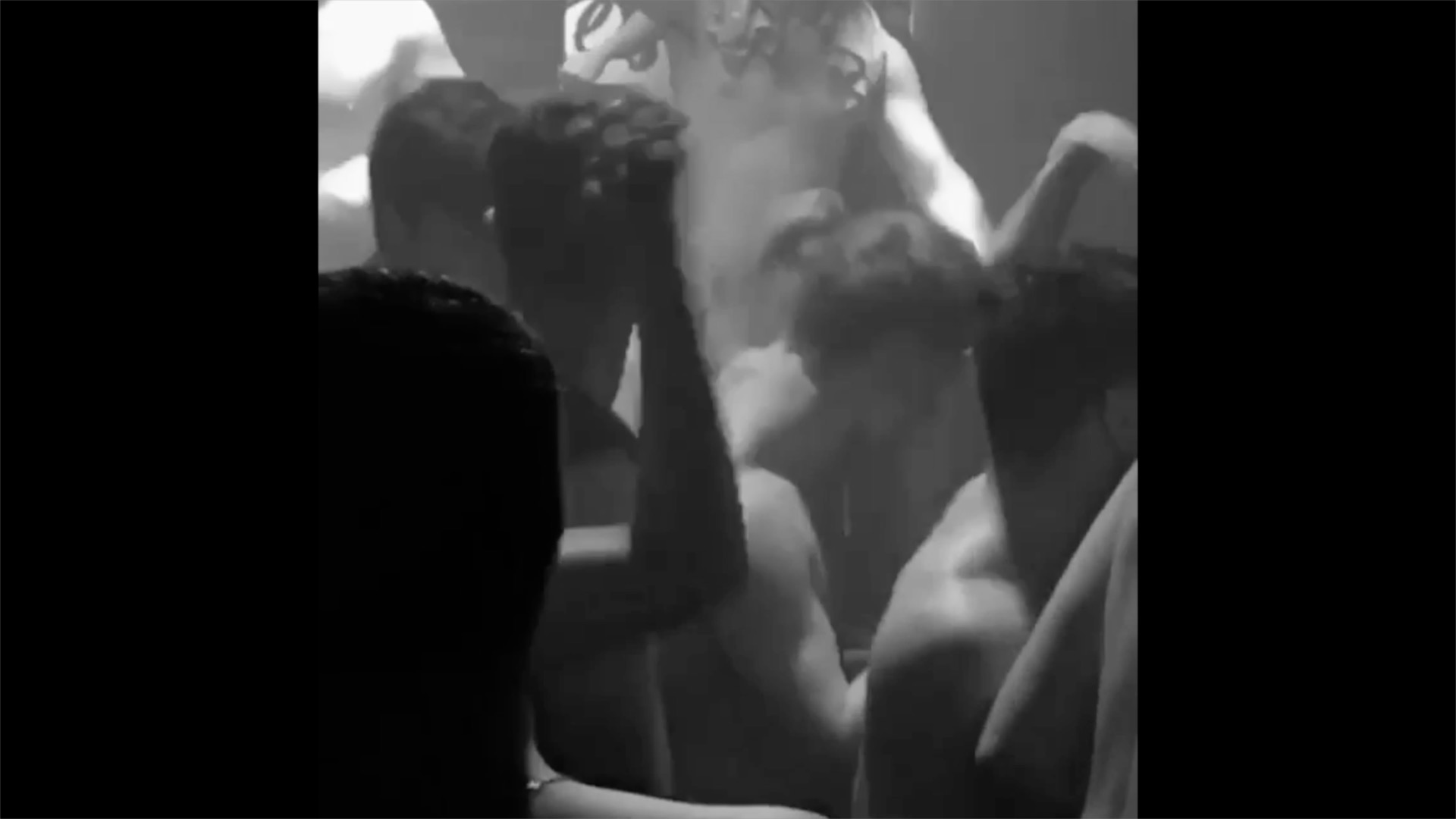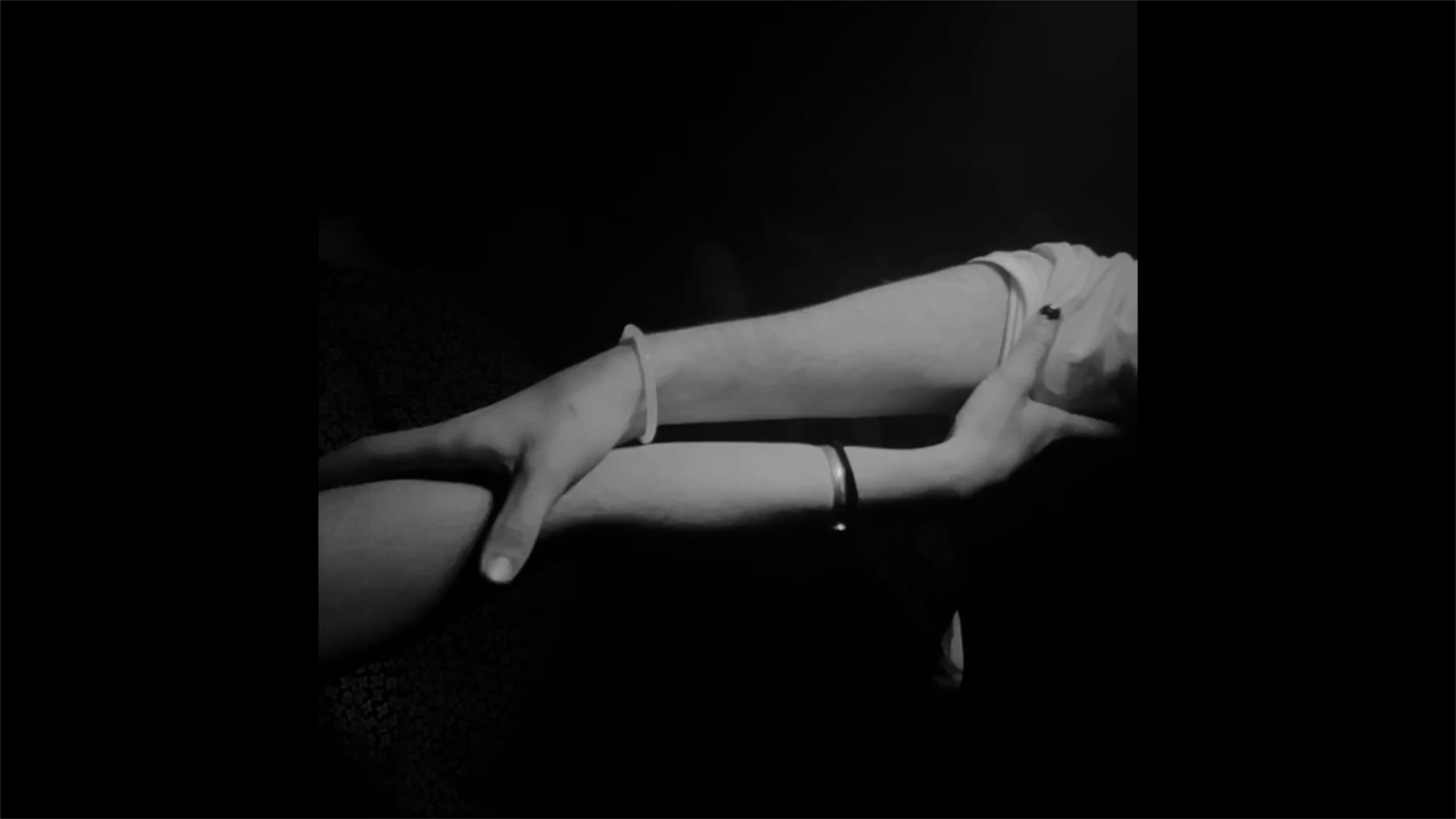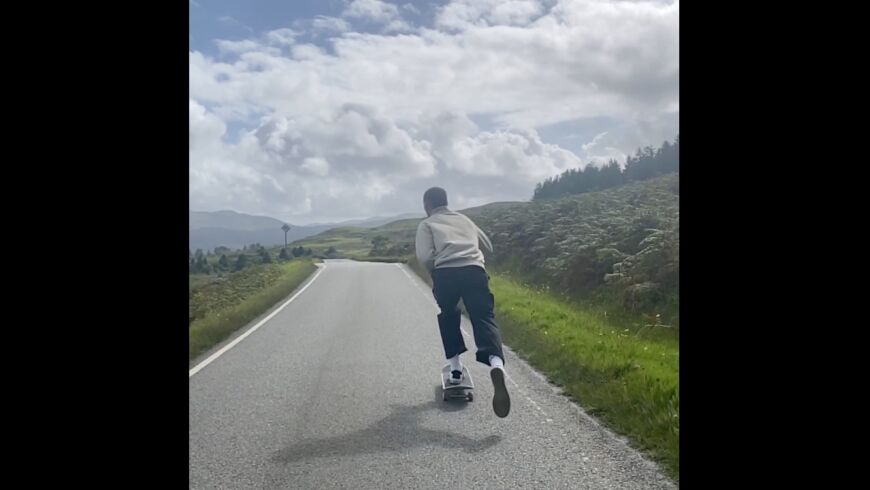States of Being
Emmie McLuskey
Emmie McLuskey unpacks our modern dependence technology, substances and ritual, as well as what it means to belong, in Cal Mac's Agony to Ecstasy.
Projects
Watch Cal Mac's Agony to Ecstasy here
It’s daylight in what looks like the beginning or the end of the summer in Scotland. A young man enters a body of water without fear. Full of volition, his strides are cautious yet purposeful. It’s clear this is a habit. Swathes of seaweed litter the banks of what appears to be a loch side. The water is a mix of pebbles and foliage, its translucency acting as a window at its most shallow and something quite opaque at its most distant. As the man swims out, he creates a perfect V shape. Small waves return to the shoreline as he enters head first towards the seabed and disappears.
Layered over the image is a voiceover of the artist’s father. His low, warm voice narrates the scene. Lyrical in tone, he recites a poem written for a younger version of the man who appears in the image. ‘I watched you change from before my eyes,’ he says, ‘Dad, I want to be a fish, you say,’ the duality of this metaphor blurring both myth and reality. Scottish folklore has long portrayed people turning into animals, their transformations often in or near water; tales, ballads, proverbs and song present the stories of creatures that hover between worlds in search of acceptance or home.
Cal Mac’s film Agony to Ecstasy reflects on what the artist describes as ‘everyday addiction’, highlighting our dependence on technology, substances and ritual, by moving through various sites that invoke an outside, both practically and metaphorically, in order to process what it means to belong. Being alone, being together; being enclosed, being outside: polar opposites collide – hot and cold, controlled and erratic, shallow and deep. Within this shifting dynamic of escapism and intimacy, desire and need, a recurring emblem is that of water.
Psychiatrist and psychoanalyst Carl Jung described water as a key symbol of what he called the ‘collective unconscious’, a shared frame of reference between members of the same species that underpins and surrounds the unconscious mind. We talk of a ‘body’ of water, as if it was an extension of ourselves, our own bodies being made of ninety percent of it; in this sense we are water and it is inside us. Water is boundary-less; even when solid it is hard to fully grasp. In Mac’s film we see water represented as a kind of salvation, a therapy. These images are juxtaposed and counterposed with clips of a club scene filmed on the artist’s iPhone. Bodies jolt and butt up against each other in what looks like ecstasy but which could easily tip over into something more sinister without too much thought. This mass of sweaty bodies could be seen as a kind of sea; its slippery, clumsy borders collide, resulting in embraces both joyous and violent. These images are accompanied by an ominous sounding monologue which weaves the personal and the scientific, hanging between experience and diagnosis; a conversation between the author and his ‘inner child’ vocalising a wrestle between what they both want and need. Of course, dependency, like water, oscillates between embracing security or falling prey to danger. In Cal’s film the dance floor and the sea offer landscapes for this struggle with uncertainty: a journey between clarity and opacity; a study of the inherent contradictions of being human.

Over the last ten years UK club music’s average BPM has slowed down from 130 to 108, a shift that coincides with austerity in Britain. There are multiple slowed-down dance scenes within Mac’s film: incidental footage of pre-Covid club nights as well as solo dances performed for camera by one of the artist’s friends. The slowness of the edit has a haunting feeling – a symbol of youth grappling with uncertainty and lack of direction, but also a retort to a world obsessed with growth and speed.
Dance floors are places for being together; some dancing solo, others with friends and lovers, all attempting to tune in to another’s consciousness and the tempo of the music. Mac’s footage mimics the rhythm of a drunken night, the strobe is drawn out allowing the sober eye to see the crowd in heightened, flashing detail; the lack of diegetic sound creating a probing quality. In the footage of the lone dancer the strobe appears again; he dances low to the ground often with his tongue out or eyes closed. A voiceover recounts moments of escape from everyday monotony: ‘getting fucked up and dancing’ as a way of keeping reality at bay; a quick fix, a promise of momentary transformation, a re-engagement with the ‘collective unconscious’, a crescendo to the inevitability of being stuck on loop. To me, Mac uses the strobe as a kind of warning; asking whether we are floating or drowning, surfing the shallows or in too deep.
In her book ‘Tendencies’, Eve Kosofsky Sedgwick speaks of the growth of addiction discourse in the chapter ‘Epidemic of the Will’. Writing in the context of late eighties/early nineties America, Sedgwick comments on the relationship between governance and freedom, mapping a history of addiction that begins in the 19th century with the uses of opium to the ‘exercise addict’ in the 1980s. Through this history she interrogates the position of freedom in the governance of self-care and how this intersects with the auspices of the state – this amalgamation of objectives coming together makes for a complex image, one which is undoubtedly porous. The majority of writing around addiction is clinical; or, if not, poses as a kind of step-by-step recovery for addicts. Sedgwick’s work, by contrast, considers an analysis of addiction as an embodied state; most addicts having to navigate a complex path of administration, violence and discrimination often laced with moral judgement in the pursuit of a more controlled form of self identity.
It feels significant that Mac turns to poetry in his observation of addiction. When words don’t come easily, in moments of collective grief or struggle, we turn to poetry as a means of holding these contradictions and multiplicities. In Mac’s voiceovers we hear from those he loves: his father, his friends, himself; we hear a voice acknowledge vulnerability, among descriptions of intertwined dependencies. In his book ‘A Lover’s Discourse’ Roland Barthes writes, ‘If I acknowledge my dependency, I do so because for me it is a means of signifying my demand: in the realm of love, futility is not a “weakness” or an “absurdity”: it is a strong sign: the more futile, the more it signifies and the more it asserts itself as strength.’[1] This is dependency shown as pure and life giving. In a recent podcast conversation between contemporary poets Ariana Reyes and Sophie Robinson, they discuss getting sober as an act of radical self-love. In Robinson’s collection ‘Rabbit’, published in 2018, at a time when she was getting sober, she describes the process of writing during this period and finding solace in the bathwater, we see her poetry embody the movement between ritual and internal and external selves.
As the nights quickly draw in as we approach the winter of 2020, our relationship to touch, our sense of being together and our notion of where we belong have been dramatically reconfigured. Our days are filled with more darkness than light. Mac leaves us with a shot of a lone figure approaching the water, the camera following his steps before he stops at the edge to sit down. We are reminded again of both vulnerability and longing. Staring out across the water what is it that we see ahead? Do we find ourselves at home or out cold and what is it that we crave? Can the tides bring hope and transformation or will they just wash us away?
Footnotes
1 Roland Barthes, A Lover’s Discourse, Penguin Books, p82 1977
References
Carl G Jung, The Structure of the Unconscious, Princeton University Press, originally written in 1916, published in 1966
Eve Kosofsky Sedgwick, Tendencies, Duke University Press. 1993
Eve Kosofsky Sedgwick, Touching Feeling: Affect, Pedagogy, Performativity, Duke University Press. 2003
Roland Barthes, A Lover’s Discourse, Penguin Books, 1977
Sophie Robinson, Rabbit, Boiler House Press. 2018
Ariana Reines and Sophie Robinson in conversation, ‘What’s Love Got to Do With It’, a three-part podcast series programmed by Beatrice Gibson, a commission by Bergen Kunsthall; Camden Art Centre, London; KW Institute for Contemporary Art, Berlin; and Mercer Union, Toronto. 2020
–––
Emmie McLuskey is an artist based in Glasgow. She works with other artists to produce collaborative work; this has previously taken the form of publications, events, objects, conversations, writing and exhibitions. Projects in 2019/20 include ’these were the things that made the step familiar’ at Collective, Edinburgh, ‘Hanging Out’ Artist Moving Image Festival co-programmed with Ima-Abasi Okon and Kimberley O’Neill at Tramway Arts, Glasgow and ‘Private Lives’ with Sarah Fastré at Sissi Club, Marseille and Dogo Residenz für Neue Kunst, Switzerland. In 2019 she published A Strange American Funeral with Freya Field- Donovan and in 2020 she was in residence at ARCUS project, Japan working on a new piece of moving image work titled Organs. In 2021/23 she will be a part of Talbot Rice Gallery's residents programme at the University of Edinburgh.
Cal Mac's Agony to Ecstasy (2020) is commissioned by Film and Video Umbrella as part of BEYOND.


